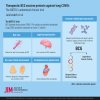https://onlinelibrary.wiley.com/doi/10.1111/joim.20033
Abstract
Background
Bacillus Calmette–Guérin (BCG) injected during the COVID-19 convalescence period was safe and enhanced recovery from anosmia and dysgeusia in the acute phase.
Objectives
To report the long-term results of the BATTLE trial, BCG vaccine in adults with mild COVID-19.
Methods
Design: Double-blind, placebo-controlled, randomized (1:1) clinical trial. Intervention: BCG intradermal vaccine and placebo. Patients: A total of 157 BCG and 142 placebo recipients participated in the 6-month follow-up, and 97 BCG and 95 placebo recipients participated in the 12-month follow-up. Measurements: Long COVID symptoms and mechanistic analyses.
Results
BCG reduced hearing problems at 6 months (odds ratio [OR] = 0.26) and sleeping, concentration, memory, and vision problems at 12 months (OR = 0.45, 0.36, 0.38, and 0.36, respectively). Sensitivity analyses confirmed that long COVID-19 symptoms were reduced at the 6- and 12-month follow-ups (p = 0.010 and 0.031, respectively). BCG's crossover interaction paradoxically increased hair loss in women and decreased it in men at 6 months (p = 0.032). BCG immunomodulation is likely mediated through inhibition of Fas ligand expression in the blood and increased induction of IL6, IL10, interferon-induced transmembrane protein 3, and angiotensin-converting enzyme 2 in cultured human macrophages.
Conclusion
Long-term follow-up of the BATTLE trial participants revealed that BCG protects against long COVID development if administered within the COVID-19 convalescence period. The response to BCG was subject-specific, including a paradoxical crossover interaction based on sex. Limitations: Not tested for previous mycobacterial exposure; loss to follow-up, particularly at 12 months.
Abstract
Background
Bacillus Calmette–Guérin (BCG) injected during the COVID-19 convalescence period was safe and enhanced recovery from anosmia and dysgeusia in the acute phase.
Objectives
To report the long-term results of the BATTLE trial, BCG vaccine in adults with mild COVID-19.
Methods
Design: Double-blind, placebo-controlled, randomized (1:1) clinical trial. Intervention: BCG intradermal vaccine and placebo. Patients: A total of 157 BCG and 142 placebo recipients participated in the 6-month follow-up, and 97 BCG and 95 placebo recipients participated in the 12-month follow-up. Measurements: Long COVID symptoms and mechanistic analyses.
Results
BCG reduced hearing problems at 6 months (odds ratio [OR] = 0.26) and sleeping, concentration, memory, and vision problems at 12 months (OR = 0.45, 0.36, 0.38, and 0.36, respectively). Sensitivity analyses confirmed that long COVID-19 symptoms were reduced at the 6- and 12-month follow-ups (p = 0.010 and 0.031, respectively). BCG's crossover interaction paradoxically increased hair loss in women and decreased it in men at 6 months (p = 0.032). BCG immunomodulation is likely mediated through inhibition of Fas ligand expression in the blood and increased induction of IL6, IL10, interferon-induced transmembrane protein 3, and angiotensin-converting enzyme 2 in cultured human macrophages.
Conclusion
Long-term follow-up of the BATTLE trial participants revealed that BCG protects against long COVID development if administered within the COVID-19 convalescence period. The response to BCG was subject-specific, including a paradoxical crossover interaction based on sex. Limitations: Not tested for previous mycobacterial exposure; loss to follow-up, particularly at 12 months.

